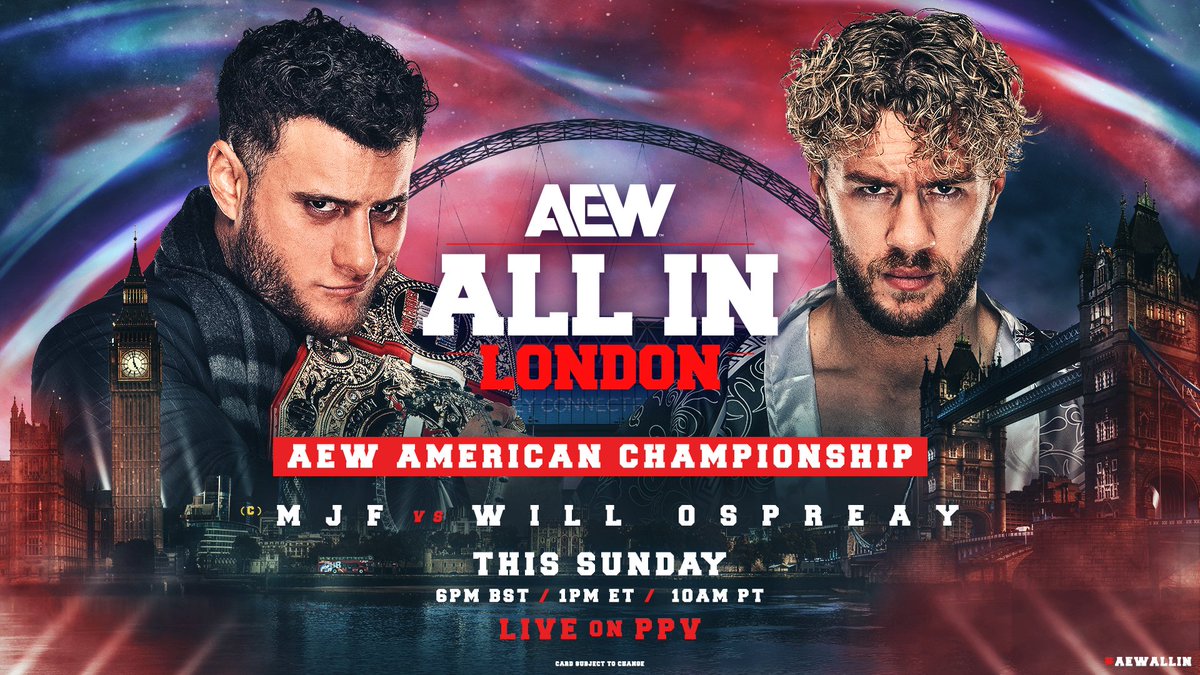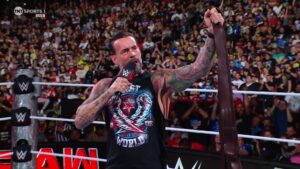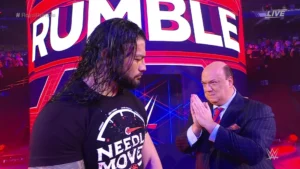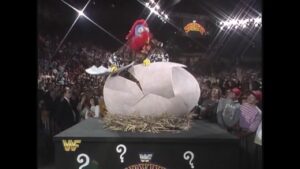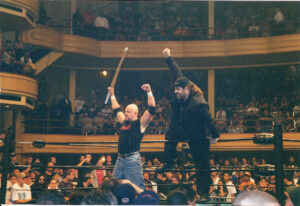Match Point is an ongoing series at Last Word on Pro Wrestling, where we look at intriguing matchups in indie wrestling and beyond. They may be dream matches, first-time matchups, or hotly anticipated rematches. In this edition, Noah Buckingham Reed will focus on AEW All In’s match-up between MJF and Will Ospreay.
Pro wrestling often tells the story of good versus evil. It is the most commonly tread story path in the history of the industry, and for good reason – it sells.
But what modern wrestling has learned to adapt is a certain level of nuance to the characters of good and evil that exist in the worlds they create. We’ve seen the magic of Roman Reigns’ family conflicts break records in WWE, Swerve Strickland’s many turns, and ‘Hangman’ Adam Page’s struggles captivate audiences in AEW.
However, what we haven’t seen done well, maybe ever, is the foreign evil heel vs home country hero schtick. We’ve seen the trope played out by the many characters of Vince McMahon’s faulty creation, even attempts more recently.
However, none for me have ever utilized the trope to build a story and set of characters quite as intriguing as Will Ospreay and MJF, where both can pull on their pasts to tell people why they’re doing what they’re doing. The heart of this rivalry is not just as simple as the good countryman vs foreign patriotic heel but more the contrast between Ospreay’s internal struggle with his past brutality and MJF’s unrelenting ruthlessness.
Ospreay’s hesitation to use the Tiger Driver ‘91, a move that symbolizes his darker side, is a powerful narrative device. It represents Ospreay’s fear of crossing a moral line, especially after injuring Bryan Danielson with that very move.
This hesitation reflects a man torn between the need to win, a desire he has had his whole life, against the desire to remain true to his honor, a value instilled in him, and instilled again through his time in Japan where honor is valued above all. On the other hand, MJF’s character is built on a very American value of self, exploiting every possible advantage with no regard for the consequences.
Many have called the character convoluted or played out, struggling to see that MJF isn’t just playing the hypocritical heel we’ve seen before but actually performing a critique on hypocrisy being played out in American society and politics right now; diversion of blame and the lack of the empathy. The Tiger Driver ‘91, which many see as the face of this story, is simply a device, a route to glory, a manifestation of this easy way out people take but those with a moral boundary will hesitate to.
MJF is now a physical manifestation of this almost Trump-like philosophy: win by any means necessary. He has taunted Ospreay by using the Tiger Driver ‘91 at every turn, MJF is willing to embrace the very darkness Ospreay fears, this level that Ospreay has never had to stoop to.
The Evolution of Ospreay: A Crisis of Conscience
Ospreay’s arc, since he appeared to injure Danielson at Dynasty, has been one of evolution. Ospreay has been a cold-blooded competitor all his career, willing to use everything in his arsenal, he has been a serial winner everywhere he has gone.
However, we have seen a substantial shift, for maybe the first time in his career. This manifested quickly, Ospreay’s hesitation in using the Tiger Driver ‘91 during the Casino Gauntlet match the week after the Dynasty match was not just about fearing injury—it felt like more of a moral awakening, finally grappling with the consequences of his actions and realizing the kind of wrestler, and person, he wants to be.
Ospreay winning the match doesn’t weaken this either, the moment is enough, we begin to understand that we are seeing a new Ospreay, one where he is no longer a prodigy who must do what it takes but a company-leading star and a role model for the next generation. A role model for his friends and the people who look up to him.
This evolution reached a critical point in the July 17 hour-long epic against MJF on Dynamite, their first clash, where Ospreay’s internal debate becomes the focal point of the closing moments. His inability to pull the trigger on the Tiger Driver ‘91 ultimately cost him the match and the International Championship.
This is where stakes were elevated; it crystallized Ospreay’s internal conflict for the first time, and it had cost him when it mattered most for the very first time. Can he be the best without compromising his newfound values?
Or must he embrace the darkness he has tried to leave behind to stop the growing evil that is MJF?
MJF: The Devil on Ospreay’s Shoulder
This is where MJF’s role in this feud becomes even more prevalent; his role is that of a manipulator, constantly pushing Ospreay towards embracing this darker side. Throughout the build, MJF has been both a taunting provocateur and a symbol of everything Ospreay fears he might become again.
By using the Tiger Driver ‘91, MJF is sending a clear message: ruthlessness wins. MJF’s tactics are designed to exploit Ospreay’s hesitation, aiming to force him into a moral quandary where the only way to win is to sacrifice his principles.
However, there now also appears to be another side to this morally corrupt MJF, he admitted on this week’s Dynamite that the fans loved him until Ospreay showed up, hinting there is a touch of jealousy towards the Brit and, within that, maybe a chance for growth. Maybe this is a beat that suggests he isn’t an inherently evil character but one that has fallen off its path, this will likely come back later down the line after this match has wrapped up but worth remembering.
Ospreay punched him after personal attacks but MJF hit out with the Diamond Ring, bloodying Ospreay before teasing the Tiger Driver ‘91, but didn’t hit it. Later in the night, Danielson gave his seal of approval to Ospreay that he should hit MJF with the move come Wembley.
The theme of honor could come back here. If Ospreay deems it the honorable thing to do, maybe he will.
This is elevated in the context of a match set in Ospreay’s home country of England and the payoff could be a satisfying conclusion for both within the feud and to serve the wider moral message. What we can see now is the story being told of MJF’s own manipulative tactics coming back to bite him and nothing being forgotten, that Ospreay isn’t one to be messed around.
Ospreay can pull into those darkest corners and eliminate the evil that is MJF and show that, when necessary, Ospreay can and will fire. That American hypocrisy and lies shouldn’t be allowed to sit without consequence.
The History of the Tiger Driver ‘91: A Move with Dangerous Origins
It feels important here to now emphasize why the Tiger Driver ‘91 is so integral here, as I said, I understand it to be a story device but there have still been many critiques around this story for its reliance on selling the danger of the move. Danielson returned a mere 2 weeks after the injury angle and it hasn’t actually put anyone away yet within AEW.
So it seems like a valid question! And it’s a question that would be easy to pass this off but it’s important to be explained as such a crucial element to this match, and AEW has attempted it in their most recent video package of this story, but I’ll do my best to explain.
Let’s make this clear, it is not just any wrestling move. It’s one with a storied and actually controversial history.
Originating in Japan, the move was popularized by Mitsuharu Misawa, one of the most revered and hard-hitting wrestlers of all time. The move, known as the Tiger Driver ’91 or the Misawa Driver, involves a high-angle sit-out double underhook powerbomb that often sees the opponent dropped on their head or neck, making it one of the most dangerous maneuvers (both in and out of kayfabe!) in professional wrestling.
Misawa, a legend in All Japan Pro Wrestling, used this move to great effect, but it also came with significant risks. The maneuver is emblematic of the intense, physical style of Japanese wrestling, where the line between real and scripted pain is often blurred.
The danger associated with the Tiger Driver ‘91 led to it being used sparingly back in Misawa’s prime years, reserved for moments when a wrestler wanted to emphasize the severity of a match or the depths they were willing to go to secure a victory, and that would have to be agreed on by all parties. Wrestling is all about pulling on history and rewarding fans for being tuned in.
The Tiger Driver ‘91 represents Ospreay’s willingness to tap into that same ruthless, unforgiving mindset of Misawa and Japanese wrestling that Ospreay has taken so much influence from. He now has to work out his internal conflict between achieving victory at any cost and preserving his integrity and the safety of his opponents.
The Role of Friends and Mentors: Fletcher, Garcia and Don Callis
I wanted to quickly comment on the added involvement of Kyle Fletcher and Daniel Garcia in this story too, and their significance. Danielson’s injury served as the catalyst for Ospreay’s crisis of conscience, but Fletcher’s involvement highlights the stakes on a personal level.
Fletcher’s loyalty and subsequent suffering at the hands of MJF further pushes Ospreay towards a potential breaking point. Don Callis’ involvement, though not always front and center, has also added a nuanced layer to the mentorship and influence theme, with Fletcher too.
Known for his manipulative, self-serving persona, Callis is a master at getting into the heads of those he associates with. His role has had a subtle but significant influence on Ospreay’s moral dilemma.
He has fallen into the background since bickering with Ospreay as Fletcher lay bloody on the mat after his beatdown at the hands of MJF. But some feel Callis maybe protested a bit too much demanding to know what took so long for Ospreay to arrive.
This had all the earmarks of a plot from him. I wouldn’t be surprised if Callis ends up supporting MJF over Ospreay come Wembley.
At least he knows MJF has the killer instinct – but again, I wouldn’t be so sure on this as he’s played a smaller role in recent weeks. But an even more important story that has gone under the radar is Daniel Garcia’s arc.
His role as a potential protege to both Ospreay and MJF underscores the theme of influence and mentorship. Garcia’s decision to reject MJF’s shortcut during his match with Ospreay only to be brutalized and now unable to compete at Wembley is a stark reminder of the dangers that come with choosing the “right” path in a world dominated by figures like MJF.
It also serves as a warning to Ospreay of what he could become if he continues to hesitate.
The Stakes at Wembley: More Than Just an AEW Title
The stakes for this match at Wembley now feel enormous, and they go beyond the AEW International (or American) Championship. This bout is about legacy, personal growth, and the clash of ideologies.
For Ospreay, it’s a chance to prove that he can be the best without reverting to his old ways. For MJF, it’s an opportunity to cement his status as the top heel in the industry by not just defeating Ospreay, but by forcing him to abandon his principles in the process.
The Wembley Stadium setting amplifies the significance of this match. With Ospreay in his home country, the pressure is on him to rise above MJF’s mind games and to represent his nation and his evolution as a wrestler from the UK Indies to becoming one of the biggest stars in North America.
For MJF, this is a chance to become a global villain, defeating a hometown hero in front of tens of thousands. It’s not just about who wins the match, but about the choices these characters make in the process and what that represents.
This match could define the legacies of both men and could very well shape the future of AEW’s narrative landscape.
More From LWOS Pro Wrestling
Header photo – AEW – Stay tuned to the Last Word on Pro Wrestling for more on this and other stories from around the world of wrestling, as they develop. You can always count on LWOPW to be on top of the major news in the wrestling world. As well as to provide you with analysis, previews, videos, interviews, and editorials on the wrestling world. You can catch AEW Dynamite on Wednesday nights at 8 PM ET on TBS. AEW Rampage airs on TNT at 10 PM EST every Friday night. AEW Collision airs Saturday at 8pm Eastern on TNT. More AEW content available on their YouTube


